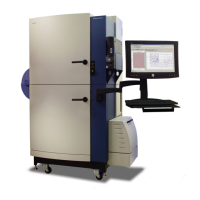Running an Experiment
168 0112-0109 H
Adjusting the Fluid Dispensing Speed
Default dispense speed is 50 μL/s, 20 μL/s and 2 μL/s when dispensing
to 96-, 384- and 1536-well plates respectively. The table below
provides recommended fluid dispense speeds for all three plate
formats.
These values must be experimentally determined for each cell type, but
it is generally preferable to dispense as fast as possible to enhance
mixing of the compounds in the wells. The trade-off is that the pipetting
speed must not be so forceful as to dislodge cells from the well.
Optimizing Fluid Volume
The fluid volume parameters have the following range:
• 96-well plate = 5–200 μL
• 384-well plate = 1–25 μL
• 1536-well plate = 0.5–3 μL
Large volumes mix more rapidly into the wells than smaller ones.
However, smaller sample volumes cause less disruption to the cell layer
and allow the same source plate to be used for multiple cell plates. To
avoid dislodging weakly adherent cells, smaller compound volumes
should be added to the cell plate, and the pipettor should dispense the
compounds at a relatively low speed.
Cell Conditions
96-Well
Plate
(μL/s)
384-Well
Plate (μL/s)
1536-Well
Plate (μL/s)
Slow dispensing speed for
weakly adherent cells or
non-adherent cells.
10–50 5–20 1–6
Fast dispensing speed for
strongly adherent cells.
100–200 25–50 5–10

